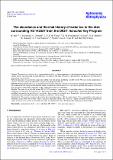Files in this item
The abundance and thermal history of water ice in the disk surrounding HD 142527 from the DIGIT Herschel Key Program
Item metadata
| dc.contributor.author | Min, M. | |
| dc.contributor.author | Bouwman, J. | |
| dc.contributor.author | Dominik, C. | |
| dc.contributor.author | Waters, L. B. F. M. | |
| dc.contributor.author | Pontoppidan, K. M. | |
| dc.contributor.author | Hony, S. | |
| dc.contributor.author | Mulders, G. D. | |
| dc.contributor.author | Henning, Th. | |
| dc.contributor.author | van Dishoeck, E. F. | |
| dc.contributor.author | Woitke, P. | |
| dc.contributor.author | Evans II, Neal J. | |
| dc.contributor.author | The DIGIT Team | |
| dc.date.accessioned | 2016-09-15T13:30:09Z | |
| dc.date.available | 2016-09-15T13:30:09Z | |
| dc.date.issued | 2016-09-01 | |
| dc.identifier | 245864068 | |
| dc.identifier | 22c6827e-fa2e-4523-9d41-906351c8df55 | |
| dc.identifier | 84984876946 | |
| dc.identifier | 000385820100005 | |
| dc.identifier.citation | Min , M , Bouwman , J , Dominik , C , Waters , L B F M , Pontoppidan , K M , Hony , S , Mulders , G D , Henning , T , van Dishoeck , E F , Woitke , P , Evans II , N J & The DIGIT Team 2016 , ' The abundance and thermal history of water ice in the disk surrounding HD 142527 from the DIGIT Herschel Key Program ' , Astronomy & Astrophysics , vol. 593 , A11 . https://doi.org/10.1051/0004-6361/201425432 | en |
| dc.identifier.issn | 0004-6361 | |
| dc.identifier.uri | https://hdl.handle.net/10023/9509 | |
| dc.description | Support for this work, part of the Herschel Open Time Key Project Program, was provided by NASA through an award issued by the Jet Propulsion Laboratory, California Institute of Technology. M.M. acknowledges funding from the EU FP7- 2011 under Grant Agreement No. 284405. | en |
| dc.description.abstract | Context. The presence or absence of ice in protoplanetary disks is of great importance to the formation of planets. By enhancing solid surface density and increasing sticking efficiency, ice catalyzes the rapid formation of planetesimals and decreases the timescale of giant planet core accretion. Aims. In this paper, we analyze the composition of the outer disk around the Herbig star HD 142527. We focus on the composition of water ice, but also analyze the abundances of previously proposed minerals. Methods. We present new Herschel far-infrared spectra and a re-reduction of archival data from the Infrared Space Observatory (ISO). We modeled the disk using full 3D radiative transfer to obtain the disk structure. Also, we used an optically thin analysis of the outer disk spectrum to obtain firm constraints on the composition of the dust component. Results. The water ice in the disk around HD 142527 contains a large reservoir of crystalline water ice. We determine the local abundance of water ice in the outer disk (i.e., beyond 130 AU). The re-reduced ISO spectrum differs significantly from that previously published, but matches the new Herschel spectrum at their common wavelength range. In particular, we do not detect any significant contribution from carbonates or hydrous silicates, in contrast to earlier claims. Conclusions. The amount of water ice detected in the outer disk requires ~80% of oxygen atoms. This is comparable to the water ice abundance in the outer solar system, comets, and dense interstellar clouds. The water ice is highly crystalline while the temperatures where we detect it are too low to crystallize the water on relevant timescales. We discuss the implications of this finding. | |
| dc.format.extent | 11 | |
| dc.format.extent | 1033254 | |
| dc.language.iso | eng | |
| dc.relation.ispartof | Astronomy & Astrophysics | en |
| dc.subject | Protoplanetary disks | en |
| dc.subject | Stars: individual: HD 142527 | en |
| dc.subject | Stars: pre-main sequence | en |
| dc.subject | QB Astronomy | en |
| dc.subject | QC Physics | en |
| dc.subject | Astronomy and Astrophysics | en |
| dc.subject | Space and Planetary Science | en |
| dc.subject | NDAS | en |
| dc.subject.lcc | QB | en |
| dc.subject.lcc | QC | en |
| dc.title | The abundance and thermal history of water ice in the disk surrounding HD 142527 from the DIGIT Herschel Key Program | en |
| dc.type | Journal article | en |
| dc.contributor.sponsor | European Commission | en |
| dc.contributor.institution | University of St Andrews. School of Physics and Astronomy | en |
| dc.identifier.doi | https://doi.org/10.1051/0004-6361/201425432 | |
| dc.description.status | Peer reviewed | en |
| dc.identifier.url | http://arxiv.org/abs/1606.07266 | en |
| dc.identifier.grantnumber | 284405 | en |
This item appears in the following Collection(s)
Items in the St Andrews Research Repository are protected by copyright, with all rights reserved, unless otherwise indicated.

